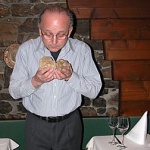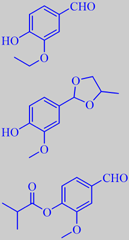



sulfides from truffle, and androstenol
Tuber melanosporum (Tuberaceae) Black truffle
Tuber magnatum (Tuberaceae) White truffle
Truffles are the underground fruiting bodies of the Tuberacean genus of mushrooms. They are completely dependent on animals to get their spores spread. Truffles have a powerful odour and are dug and eaten by wild-boars, who can smell them from a distance. In this way the large, thick-walled spores are dispersed. The above-mentioned species have mycorrhiza with oak trees and prefer calcareous ground. They are mostly found in southern Europe, North Africa and North America. Especially in France and Italy, the truffles are appreciated in gastronomy. They have been praised since antiquity but are hard to find. Pigs have been used, with a ring and a strap in their nose to prevent them from eating the truffles. Nowadays trained dogs are used. One sign of truffles in the soil may be 'dancing' specimens of the truffle fly, Suilla gigantae, above the place.
Black and white truffles are the most appreciated. The white truffle is considered to be the finest. It is called 'The white diamond of Piedmont'. The price is about 270 EUR pr. 100 g at the Italian markets. Wafer thin flakes of the fresh truffles on top of warm dishes provide elegant sulfury nuances accentuating the whole aroma.
The most important aroma compounds in truffles are a number of characteristic sulphides: dimethyl sulphide, also known from asparagus, 2,4-dithiapentane, in dilution reminiscent of garlic, and 2,4,6-trithiaheptane. Moreover, black and white truffles contain the musk- and sandalwood-smelling androstenol (5-alpha-androst-16-ene-3-alpha-ol). This steroid alcohol is a sex pheromone in the boar, and it has been taken for granted that this was the attracting odorant. However, new field experiments with burrowed truffles and sources with 2,4-dithiapentane and androstenol have shown that only the first two made the animals respond [30]. Androstenol is also present in the sweat from men's armpits, Homo sapiens ssp. sapiens.
Etymology: Fr. trufle, related to Lat. tuber, abscess or bulb.



6(Z),9(Z)-dodecadiene-4-olide, tuberolide and tuberolactone
Tuberose
Polianthes tuberosa (Agavaceae or Amaryllidaceae)
Tuberose is among the most fragrant of flowers. It was domesticated by
the pre-Columbian Indians in Mexico and is not known as a wild plant.
Tuberose was one of the first plants taken back to the Old World. It was
adored by the Spanish and often used in their gardens. It is still today
a popular plant in Mexico where it is often placed in pots located near
patios, walk ways, decks, and other living space so that the fragrant
flowers may be enjoyed to the fullest.
Tuberose is about a metre high, the leaves are long and slender, the flowers
are waxy white and slightly full-bodied on the borders, and grouped in
loose spikes. They are 5-6 cm long and have a characteristic bending.
Tuberose is a fragile plant. Each year the shallow root bulbs must be
unearthed to keep them from frost and to diminish the risk of rot, and
next spring only the largest bulbs replaced, to be sure of florescence.
Tuberose has a high reputation in perfumery. The plants are cultivated
in Morocco, Egypt and India. A tuberose absolute was formerly produced
in southern France by enfleurage (by enfleurage the volatiles from the
freshly picked flowers are absorbed in paraffin shavings with subsequent
alcoholic extraction), but now it is obtained by solvent extraction, via
the concrete (see boronia
for a description of this process). The absolute is a dark orange to brown
viscous liquid with an extremely heavy-sweet, narcotic-floral and somewhat
spicy odour reminiscent of honeysuckle,
peru balsam,
neroli, stephanotis,
etc. Its main constituents are benzyl alcohol and -acetate, methyl and
benzyl benzoate, methyl salicylate, methyl anthranilate, eugenol, geraniol
and nerol and -acetates, and farnesol, but its power and original effect
is due to a multitude of gamma- and delta-lactones, some of them only
found in tuberose [105] [106]. Three of them are shown above.
Tuberose absolute is incorporated in a number of recent perfumery masterpieces,
e.g. Poison (Dior 1985).
Etymology: Lat. tuber, bulb.




ar-turmerone, turmerone and curcumin
Curcuma longa (Zingiberaceae)
The curcumas of the ginger family are natives of tropical Asia. Turmeric has been domesticated since old ages for its rhizome, which is important as a colorant and as a spice. The dried and ground rhizome is an essential constituent of curry powder. Moreover, turmeric seems to have many healthful properties and is currently being investigated for possible benefits in Alzheimer's disease, cancer, liver disorders and various infections.
Sangli, a town in the southern part of the Indian state of Maharashtra, is the largest and most important trading centre for turmeric in Asia.
In the fresh state, the rootstock has an aromatic and spicy fragrance. The steam distilled essential oil has a warm, spicy, slightly woody aroma. It consists mainly of sesquiterpenes with ar-turmerone and turmerone as major compounds [82]. Curcumin, the main colouring substance, is 1,7-bis(4-hydroxy-3-methoxyphenyl)-1(E),6(E)-heptadiene-3,5-dione, or diferuloylmethane, also called Natural Yellow 3. It is not light fast.
Etymology: turmeric, from Lat. terra merita, meritorious earth, probably because ground turmeric resembles ochre. Curcuma (and crocus) is derived from Persian karkam for saffron.




isovaleric acid
and myrtenyl isovalerate

actinidine and
nepetalactone
Valeriana officinalis (Valerianaceae)
The dried roots of valerian smell unmistakably of 3-methylbutanoic acid (isovaleric acid, 'sour toes'), but more pleasantly smelling elements may also be perceived, e.g. myrtenyl isovalerate. Small amounts of various sesquiterpenes are present too, e.g. valerianol [107]. Extracts from valerian roots are available in pharmacies as a mild sedative. Earlier, when the pharmacies made their own extracts and discarded the roots in the backyards, one could see cats from the town roll upon them. Male cats are mad with some pyridine alcaloids in valerian root, e.g. the iridoid monoterpene actinidine, resembling the active ingredient nepetalactone in catnip (or catmint), Nepeta cataria (Labiatae) [108] [109].
Etymology: Lat. valere, to be healthy; Lat, valero, I am healthy, ref. the Roman emperor Valerian (253-260 A.D.).




vanillin and a vanilla vitispirane
Vanilla
Vanilla planifolia (Orchidaceae) Bourbon vanilla
There are some 110 species of Vanilla orchids distributed across
the tropics, but those developing aromatic pods are native to tropical
America. By far the most of the world's vanilla comes from the cured beans
of just one of these species, Vanilla planifolia, a scrambling
vine-like plant that grows wild in the forests of Central America, although
the plant is rare in nature. However, the Mayan people were well acquainted
with it and used it to flavour their chocolate drinks. In the early 19'th
century, the French established plantations in Madagascar and Réunion
in the Indian Ocean, and today most vanilla comes from these islands [205].
The long, slender fruits ('beans' or 'pods') are harvested before they
ripen, but the powerful vanilla flavour only develops after a several
months of special curing. The beans are spread in the sun in the morning,
then covered and kept enclosed during the night. After a while the green
beans turn brown, and the glycosidically bound vanillin is slowly liberated.
It is understandable why vanilla is so expensive. The small black points
in the dessert, showing that true vanilla has been used, are the seeds,
unusually large for orchids. White fluffs on the surface of the vanilla
pods are neither mould nor insecticide, but pure crystallized vanillin,
and a sign of high quality. The major part of the world's vanilla is used
for making vanilla extracts, used on a large scale in finer chocolate,
ice-cream, cookies, etc. The Danish company Danisco
has become an important actor on this market.
Vanillin, or 4-hydroxy-3-methoxybenzaldehyde, is definitely the major
odorant from vanilla, but several additional aroma compounds are formed
during the curing process (more than 100 are identified). Guaicol, creosol,
acetovanillone, vanillyl alcohol and methyl salicylate seem to be of importance,
together with vitispiranes [110] [111].
Already in 1876 Reimer and Tiemann succeeded in synthesizing vanillin
in the laboratory. Pure vanillin is used as an odorant for many purposes.
It has a powerful, sweet vanilla odour, but without the rich complexity
of the vanilla bean.




anisyl compounds from Tahiti vanilla
Vanilla tahitensis (Orchidaceae) Tahiti vanilla
The origins of Tahiti vanilla are somewhat obscure as the plant is not
known from the wild and originally was an alien to Polynesia. Recent investigations
suggest it to be a hybrid of Vanilla planifolia and a less familiar
species, Vanilla odorata, that may have arisen in Mayan gardens
many centuries ago (in what is now Guatemala) and sooner brought to Tahiti
by Spanish ships [205].
In spite of numerous reports in popular chemical literature that the more
floral aroma of Tahiti vanilla is due
to heliotropin (piperonal, 3,4-methylenedioxybenzaldehyde) this is not
true! Maybe this misconception has arisen from the fact that heliotropin
is used as an enhancer in artificial vanilla aromas where it acts as a
synergist to vanillin.
Cured Tahiti vanilla beans are relatively low in vanillin. Instead they
contain a number of anisyl compounds with anisyl alcohol, anisaldehyde,
dianisyl ether and anisyl ethyl ether as some of the major characteristic
ingredients [206].
In perfumes vanillin must be used very discretely. Its sweetness is sickening in overdose, but minute amounts are very helpful in the final rounding of a composition. Several 'derivatives' of vanillin are used, each one having its special asset. The homologue 'ethylvanillin' or Bourbonal is about three times as powerful as vanillin and has a warmer and slightly more floral character. Where the tendency of vanillin to form coloured reaction products is a problem, the cyclic acetal with propyleneglycol may be used. Its odour is somewhat weaker, but still have the characteristic sweetness. A newer, successful member of the 'vanillin family' is Isobutavan ® with a "sweet and creamy vanillic character reminiscent of white chocolate, cream soda and with a soft apricot feeling" (Givaudan).
Isobutavan, at around 2 %, and together with patchouli, plays an important part in the base note of the Oriental-ambery-gourmand fragrance A*Men (Mugler 1996) [43].

'ethylvanillin'
Bourbonal
vanillin propylene- glycol acetal
Isobutavan ®

